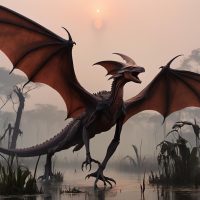Kongamato : The Boat Breaker
Listen
At a glance
| Description | |
|---|---|
| Origin | Southern African Mythology |
| Classification | Hybrids |
| Family Members | N/A |
| Region | Angola, Zambia |
| Associated With | Destruction, Swamps |
Kongamato
Introduction
The Kongamato is one of Africa’s most enduring mythological mysteries, emerging from the folklore of the Kaonde and Bemba peoples of Zambia, as well as parts of Angola and the Congo. Described as a fearsome, winged reptilian creature resembling a prehistoric pterosaur, the Kongamato’s legend has captivated storytellers, explorers, and cryptozoologists alike. Its name translates to “overturner of boats,” a title earned from its notorious habit of attacking fishermen and capsizing canoes that dare to cross its watery domain. In traditional belief, rivers and swamps are thresholds between the human and spirit worlds, and the Kongamato is often regarded as a supernatural guardian of these sacred places. The creature’s story gained international attention when British explorer Frank H. Melland documented it in his 1923 book In Witchbound Africa, where he recounted how locals identified the Kongamato with pterosaur illustrations—centuries before such creatures were popularized by modern media.
Physical Traits
In folklore, the Kongamato is described as a large, leathery-winged creature with unmistakably prehistoric features. It has a wingspan estimated between four and seven feet, though some exaggerated accounts claim it could reach up to a hundred feet. Its body is covered in reddish-black or brown scales, completely devoid of feathers, giving it a reptilian and menacing appearance. The creature’s head is said to have a long, pointed beak filled with jagged teeth—an unusual detail since modern birds lack such features. Witnesses claim it has glowing red eyes, and its wings, like those of a bat, are thin and membranous. These consistent details across oral traditions and explorer accounts have led many to compare the Kongamato to a surviving species of pterosaur or to interpret it as a symbolic representation of natural forces lurking within Africa’s swamplands. Its terrifying cry, often described as a shrill screech, is believed to foretell disaster for anyone who hears it near the water.
Family
Unlike deities or spirits with genealogical ties, the Kongamato exists as a solitary being within African folklore. It is neither part of a pantheon nor associated with a divine lineage. Instead, it is perceived as a spiritual force—an ancestral guardian or vengeful spirit watching over rivers, lakes, and swamps. Among the Bemba, natural spirits are often linked to ancestral energy, suggesting that the Kongamato might embody the wrath of ancient protectors of the land and water. Its independence and isolation from other mythical beings enhance its fearsome mystique, presenting it as both a physical predator and an elemental force that enforces respect for nature’s boundaries. Similar flying monsters appear in nearby regions under different names, such as the Olitiau of Cameroon and the Batamzinga of Kenya, implying a shared mythic archetype of winged enforcers guarding sacred places across Central and East Africa.
Other names
The name “Kongamato,” derived from the Kaonde and Bemba languages, literally means “overturner of boats” or “breaker of boats.” The title reflects the creature’s association with danger on waterways and its reputation for attacking anyone who intrudes into its territory. In Cameroon, a comparable creature is known as the Olitiau, described as a giant bat-like predator. In Kenya, a similar legend speaks of the Batamzinga, a winged beast of ill omen. Western explorers and writers have sometimes referred to the Kongamato as the “African Pterosaur” or “Swamp Demon of Zambia.” Each name carries with it a sense of dread, emphasizing the creature’s destructive potential and deep connection to untamed natural forces. Across cultures, these varied names reveal how the same mythological image—the monstrous bird or dragon of the waters—emerges repeatedly in response to humanity’s fear of the unknown.
Powers and Abilities
The Kongamato is best known for its violent temperament and supernatural strength. True to its name, it can capsize canoes and small boats, either by diving from above or through sudden gusts of wind that stir the waters. Its sharp beak and talons are said to tear through flesh and wood alike, making it a deadly presence in the wilderness. In traditional belief, the creature is not merely a predator but a guardian spirit, punishing those who disrespect sacred waters or exploit nature’s gifts. It is said to emerge most often at dusk, its wings blotting out the setting sun as it glides silently over the swamps.
Local stories claim that conventional weapons cannot harm the Kongamato—spears and bullets are said to bounce off its scaly hide or even be swallowed mid-flight. This supposed invulnerability reinforces its status as a supernatural being rather than a mere animal. Some tribes believed rituals or charms could offer protection, including the muchi wa kongamato, made from sacred tree roots mixed with river water. Sightings of the Kongamato were also viewed as omens of disaster, such as floods, disease, or death within a community. In this sense, it acts both as a physical danger and a moral warning, reminding people to honor their environment and maintain harmony with the spirit world.
Modern Day Influence
In modern times, the Kongamato has transcended its regional origins to become a topic of fascination in cryptozoology and popular culture. Western explorers and adventurers in the early 20th century, including Melland and later J.P. Mill, fueled speculation that a living pterosaur might inhabit the African interior. These reports inspired articles in The Illustrated London News and later discussions in books and documentaries about “living dinosaurs.” Although no scientific evidence supports these claims, they cemented the Kongamato’s status as one of the most intriguing cryptids in African lore.
Today, the Kongamato appears in various forms of media. In video games like Final Fantasy XIV, it is depicted as a monstrous flying mount, while in modern fantasy literature such as Roger Lawrence’s Kongamato, the creature re-emerges in contemporary settings as a symbol of chaos and fear. Cryptid enthusiasts continue to compare it with other winged legends such as the Ropen of Papua New Guinea, the Ahool of Indonesia, and the Thunderbird of North America, drawing parallels between global myths of sky predators.
Beyond popular media, the Kongamato also carries ecological and cultural symbolism. Some scholars interpret its legend as an ancestral warning against environmental neglect, particularly deforestation and the destruction of wetlands that sustain local ecosystems. In Zambia, the story endures in oral performances, folk songs, and regional tourism narratives around the Mwinilunga district, where locals speak of eerie lights and screeches echoing across the Jiundu swamps.
The Kongamato’s legend stands as a bridge between past and present—between myth and mystery. It continues to inspire both awe and caution, symbolizing humanity’s enduring fear of the unknown and its respect for nature’s power. Whether seen as a surviving relic of prehistory or as a spiritual guardian of Africa’s wild waters, the Kongamato remains a powerful figure in the mythology of the continent, an embodiment of both the danger and wonder that define the natural world.
Related Images
Source
A Book of Creatures. (2019, May 20). Kongamato. Retrieved from https://abookofcreatures.com
Childress, D. H. (1989). Lost Cities & Ancient Mysteries of Africa and Arabia. Adventures Unlimited Press.
Eberhart, G. (2002). Mysterious Creatures: A Guide to Cryptozoology. ABC-CLIO.
Face2Face Africa. (2021). Kongamato: The real ‘Batmen’ of East Africa. Retrieved from https://face2faceafrica.com
Fairy Tales and Myths. (2023). Kongamato. Retrieved from https://fairytalesandmyths.com/kongamato
Melland, F. H. (1923). In Witchbound Africa. J. B. Lippincott Company.
Monstropedia. (1994). Kongamato. Retrieved from https://www.monstropedia.org
Symbol Hunt Zambia. (2022). The Mythical Creature of Zambia: Kongamato. Retrieved from https://symbolhunt.com/zambia/mythical-creature/
Frequently Asked Questions
What is lorem Ipsum?
I am text block. Click edit button to change this text. Lorem ipsum dolor sit amet, consectetur adipiscing elit. Ut elit tellus, luctus nec ullamcorper mattis, pulvinar dapibus leo.
What is lorem Ipsum?
I am text block. Click edit button to change this text. Lorem ipsum dolor sit amet, consectetur adipiscing elit. Ut elit tellus, luctus nec ullamcorper mattis, pulvinar dapibus leo.
What is lorem Ipsum?
I am text block. Click edit button to change this text. Lorem ipsum dolor sit amet, consectetur adipiscing elit. Ut elit tellus, luctus nec ullamcorper mattis, pulvinar dapibus leo.
What is lorem Ipsum?
I am text block. Click edit button to change this text. Lorem ipsum dolor sit amet, consectetur adipiscing elit. Ut elit tellus, luctus nec ullamcorper mattis, pulvinar dapibus leo.
What is lorem Ipsum?
I am text block. Click edit button to change this text. Lorem ipsum dolor sit amet, consectetur adipiscing elit. Ut elit tellus, luctus nec ullamcorper mattis, pulvinar dapibus leo.





